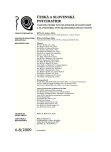Neuromechanisms of Addictive Substances, Reward System
Authors:
P. E. Váchová; S. Racková; L. Janů
Authors‘ workplace:
Psychiatrická klinika LF UK a FN, Plzeň
přednosta doc. MUDr. J. Beran, CSc.
Published in:
Čes. a slov. Psychiat., 105, 2009, No. 6-8, pp. 263-268.
Category:
Comprehensive Reports
Overview
Addiction on psychoactive substances is a complex, multifactorial illness, which evolves from the interaction of genetic predisposition and environmental factors. Several models describe the creation and evolution of addiction. One of the most important ones is the reward system, which is created on the basis of dopamine hypothesis. Basic interaction takes place between the ventral tegmental area, nucleus accumbens and the prefrontal cortex. Psychoactive substances (pathological sources of rewards) cause many sorts of biochemical changes in the brain, which have a similar reactive mechanism as physiological sources (sex, food). However, their reaction time and ease of achieving the feeling of pleasure differ significantly. There are no physiological mechanisms which would ensure the preference of natural rewards.
Key words:
dopamine hypothesis, nucleus accumbens, reward, prefrontal cortex, reward system, ventral tegmental area.
Sources
1. Bečková, I., Višňovský, P.: Farmakologie drogových závislostí. Praha, Karolinum, 1999.
2. Berke, J. D., Hyman, S. E.: Adidction, dopamine, and the molecular mechanism of memory. Neuron, 25, 2000, pp. 515-532.
3. Bowirrat, A., Berman, M. O.: Relationship between dopaminergic neurotransmission, alcoholism, and reward deficiency syndrome. Americal Journal of Medical Genetics, 132B, 2005, pp. 29-37.
4. Charney, D. S., Nestler, E. J., Bunney, B. S.: Neurobiology of mental illness. New York, Oxford, Oxford University Press, 1999.
5. Fišar, Z.: Psychiatrie. Praha, Galén, Karolinum, 2001.
6. Hoffman, A. F., Oz, M., Caulder, T., Lupica, C. R.: Functional tolerance and blockade of long-term depression at synapse in the nucleus accumbens after chronic cannabinoid exposure. Journal of Neuroscience, 23, 2003, 12, pp. 4815-4820.
7. Hyman , S. E.: Addiction: a disease of learning and memory. American Journal of Psychiatry, 162, 2006, pp. 1414-1422.
8. Kalina, K. a kol.: Základy klinické adiktologie. Havlíčkův Brod, Grada, 2008.
9. Kalivas, P. W., Volkow, N. D.: The neural basis of addiction: a pathology of motivation and choice. American Journal of Psychiatry, 162, 2005, pp. 1403-1413.
10. Kelley, A. E., Berridge, K. C.: The neuroscience of natural rewards: Revalence to addictive drugs. The Journal of Neuroscience, 22, 2002, pp. 3306-3311.
11. Klennerová, V.: Strukturálně funkční změny u stresu a poruch chování. Psychiatrie, 10, Suppl. 2, 2006, pp. 17-22.
12. Koob, G. F., Le Moal, M.: Drug addiction, dysregulation of reward, and allostasis. Neuropsychopharmacology, 24, 2001, 2, pp. 97-129.
13. Koob, G. F.: The neurobiology of addiction: a neuroadaptational view relevant for diagnosis. Addiction, 101, 2006, Suppl. 1, pp. 23-30.
14. Nestler, E. J.: Total recall – the memory of addiction. Science, 292, 2001, (5525), pp. 2266-2267.
15. Nešpor, K.: Návykové chování a závislost. Praha, Portál, 2000.
16. Nicola, S. M., Surmier, D. J., Malenka, R. C.: Dopaminergic modulation of neuronal excitability in the striatum and nucleus accumbens. Annual Review of Neuroscience, 23, 2000, pp. 185-215.
17. Smolík, P.: Duševní a behaviorální poruchy. Praha, Maxdorf, 2002.
18. Weiss, F., Porrino, L. J.: Behavioral neurobiology of alcohol addiction: recent advances and challenges. Journal of Neuroscience, 22, 2002, 9, pp. 3332-3337.
Labels
Addictology Paediatric psychiatry PsychiatryArticle was published in
Czech and Slovak Psychiatry

2009 Issue 6-8
Most read in this issue
- Neuromechanisms of Addictive Substances, Reward System
- Schizophrenia in Mentally Retarded Patients, Diagnostic Consideration and Practical Experience
- Psychosomatic Transformation of Peripheral Somatic Disorder (Benign Paroxysmal Position Verig)
- Addictive Behavior on the Internet and Its Treatment
